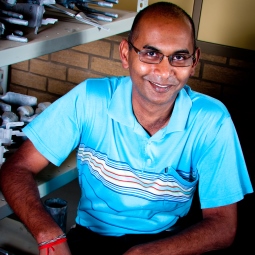Research and development to maximise the benefit from the aluminium value chain
Light metals experts at the CSIR have been instrumental in product development and improvement of light metal manufacturing processes. The research and development undertaken has the potential to add significant value to the aluminium value chain.
Light metals experts at the CSIR have been instrumental in product development and improvement of light metal manufacturing processes. The research and development undertaken has the potential to add significant value to the aluminium value chain.
“The transport industry is continuously working toward fuel efficiency in an effort to meet international environmental regulations. Lightweighting of vehicles is one of the more cost effective methods of achieving this. This has led to the increased use of aluminium. While South Africa has a well-established aluminium industry, the country is not benefiting optimally from this opportunity in the aluminium industry. Most of our metal smelted at the South32 smelter in Richards Bay is exported,” says Dr Sagren Govender, who leads research in advanced casting technologies at the CSIR.
In response, the Department of Science and Technology initiated the development of the South African Aluminium Industry Roadmap. The CSIR finalised the roadmap earlier this year with input from senior government officials, academia, aluminium industry leaders, the Aluminium Federation of South Africa and representatives from downstream users of aluminium.
“The roadmap paves the way to doubling the local demand for aluminium products, which could double the employment, contribution to GDP and export earnings. CSIR experts in the field of materials science, foundry and laser technology, as well as technology localisation have been working on technology innovations that could see many spinout companies in the next ten years to realise goals set out in the Roadmap,” says Govender.
The CSIR’s collaboration with a local company, Paltechnologies (Pty) Ltd (Paltech), has resulted in the successful development of a standard 80 mm diameter butterfly valve installed on electrical power transformers. This aluminium valve is specifically designed to handle transformer cooling oil. A variable number of valves are required on a transformer, depending on the size and amount of oil required to cool it. A local transformer manufacturing company, Powertech (Pty) Ltd and Eskom tested the valve to ensure that it meets stringent industry requirements.
“Until now, these valves were imported. South Africa produces aluminium from imported bauxite, an aluminium ore, much of which is exported instead of being used to locally produce our own components for the local market. With the design and manufacturing of components such as the Paltech valves, we are completing the value chain with a quality product,” says Govender.
Early estimates are that the manufacture of this valve has the potential to create at least 40 new and sustainable jobs. To date, at least 260 valves have been manufactured, and an order for 300 more has been placed.
In an effort to support local component development in the aluminium industry, the CSIR is also helping local designers to build prototypes using a 3D printer to produce wax patterns. Moulds are made and prototypes cast using light metals such as aluminium.
The CSIR also produced prototype castings of an air gun frame for a local company. The frame is being modified to improve its mechanical performance and has potential to go into production soon.
Wispeco, a leading aluminium extrusion company, was assisted by the light metals aluminium research team to improve its process consistency. The CSIR-developed reduced pressure tester was also introduced into the foundry operation for the casting of extrusion billets. The project resulted in an estimated saving of R6 million per year.
The CSIR also provided technical advice to a local manufacturing company to localise the production of two aluminium castings for the automotive industry. This resulted in the local production of castings to the value of approximately R10 million per year.
Govender says it is the vision of the South African Aluminium Industry Roadmap that this industry becomes a competitive supplier of material and unique, finished products, focusing on regional and global markets as a net exporter. He says that if the country continues to grow capacity in the aluminium industry, optimising resources in an energy-efficient, sustainable and environmentally friendly way, it would lead to significant job creation and socio-economic upliftment.


